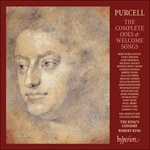With
Celebrate this Festival we come to the fifth of six Odes Purcell wrote to celebrate the birthday of Queen Mary in successive years from 1689. By 1693 the scoring of the orchestra had been increased to include oboes, recorders and a trumpet and, although the basic plan remained the same, the size and scale of the Odes and their dramatic content had increased. The choruses, often developing out of a series of solo sections, had increased in length and, in the interests of keeping pace with the libretto, instrumental ritornelli had all but vanished, with sections running instead straight into a contrasting vocal movement. Purcell worked closely with the famous trumpeter John Shore, and possible now were movements with virtuoso obbligato trumpet parts, of which the suitably military ‘While, for a righteous cause’ is a splendid example. Similarly, the presence of both oboes and recorders in the orchestra (oboists usually doubled on recorders) enabled delicately scored movements such as ‘Return, fond Muse’ (scored for two recorders and viola). The Symphony, much grander in scale than those of ten years before, was on this occasion copied directly from
Hail! bright Cecilia, performed just six months previously, and Purcell was obviously blessed with two fine sopranos, whose opening duet sets a suitably stately tone for the Ode. But there is also writing of great beauty too, in particular the quietly ecstatic setting for solo alto, over a ground bass, of ‘Crown the altar’. Effective, too, is the wonderful seven-part vocal texture at ‘Repeat Maria’s name’ which throws the Queen’s name between voices and instruments before a minuet closes the work in elegant vein.
from notes by Robert King © 2010
Avec
Celebrate this Festival, nous voici à la cinquième des six Odes écrites par Purcell de 1689 à 1694, pour l’anniversaire de la reine Marie. La distribution orchestrale de cette œuvre de 1693 est agrémentée de hautbois, de flûtes à bec et d’une trompette et, si le plan de base demeure inchangé, la taille et l’envergure des Odes, mais aussi leur contenu dramatique se sont amplifiés. Les chœurs, souvent développés à partir d’une série de sections solo, ont gagné en longueur et, pour suivre le rythme du livret, les ritornelli instrumentaux ont presque tous disparu, les sections embrayant plutôt avec un mouvement vocal contrastif. Purcell travailla en étroite collaboration avec le célèbre trompettiste John Shore et les mouvements avec parties de trompette obligée virtuose lui devinrent possibles, tel le militaire, et splendide, «While, for a righteous cause». De même, la présence, dans l’orchestre, de hautbois et de flûtes à bec (généralement tenues par les hautboïstes) permit des mouvements délicatement écrits comme «Return, fond Muse» (pour deux flûtes à bec et alto). Pour cette Ode, la Symphonie, bien plus grandiose que toutes celles des dix années passées, fut directement empruntée à
Hail! bright Cecilia, jouée tout juste six mois plus tôt. Purcell avait manifestement le bonheur d’avoir deux remarquables sopranos et leur duo inaugural instaure le ton solennel qui convient à cette Ode. Mais on découvre aussi une écriture de toute beauté ailleurs, notamment dans le «Crown the altar» pour alto solo, paisiblement extatique par-dessus un ground bass. Tout aussi impressionnante, la merveilleuse texture vocale à sept parties, à «Repeat Maria’s name», lance le nom de la reine entre les voix et les instruments avant qu’un menuet ne vienne élégamment clore l’œuvre.
extrait des notes rédigées par Robert King © 2010
Français: Hypérion
Mit
Celebrate this Festival kommen wir zu der fünften der sechs Oden, die Purcell anlässlich des Geburtstags von Königin Maria regelmäßig ab 1689 schrieb. Purcell erweiterte die Anlage im Laufe der Zeit, so dass 1693 im Orchester auch Oboen, Blockflöten und eine Trompete auftraten und obwohl die Gliederung im Großen und Ganzen gleich blieb, hatten sich der Umfang und die Anlage der Oden und ihres dramatischen Inhalts erweitert. Die Chöre, die sich oft aus einer Reihe von Solo-Abschnitten entwickelten, waren länger geworden und um mit dem Libretto Schritt zu halten, waren die instrumentalen Ritornelle fast verschwunden, so dass die verschiedenen Abschnitte stattdessen direkt in einen kontrastierenden Vokalsatz übergingen. Purcell arbeitete eng mit dem berühmten Trompeter John Shore zusammen und es waren nun Sätze mit obligater Trompetenstimme möglich, wofür das passend militärisch anmutende „While, for a righteous cause“ ein sehr gutes Beispiel ist. Dementsprechend machten die Oboen und Blockflöten im Orchester (wobei die Oboen die Blockflöten zumeist verdoppelten) feingliedrige Sätze wie etwa „Return, fond Muse“ (das für zwei Blockflöten und Bratsche angelegt ist) möglich. Die Sinfonie, die eine sehr viel größere Anlage hat als diejenigen der vorangegangenen zehn Jahre, wurde zu dieser Gelegenheit direkt aus Hail! bright Cecilia kopiert, das erst sechs Monate zuvor aufgeführt worden war, und Purcell standen offenbar zwei sehr gute Soprane zur Verfügung, deren Anfangsduett eine gebührend prächtige Atmosphäre zu Beginn des Werks herstellt. Doch auch andere Sätze sind wunderschön komponiert, insbesondere der stille, ekstatische Satz für Solo-Alt, „Crown the altar“, der über einem Basso ostinato erklingt. Ebenfalls wirkungsvoll ist die wunderbare siebenstimmige Vokaltextur bei „Repeat Maria’s name“, wo der Name der Königin zwischen Stimmen und Instrumenten hin- und hergereicht wird, bis ein Menuett das Werk in eleganter Weise beendet.
aus dem Begleittext von Robert King © 2010
Deutsch: Viola Scheffel


 Purcell: The Complete Odes & Welcome Songs
Purcell: The Complete Odes & Welcome Songs
